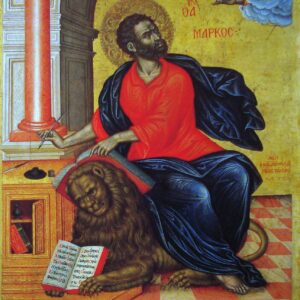 After taking a mid-summer “break” to devote ourselves to John 6, we are now ready to dive back into St. Mark’s Gospel until the end of the Church’s year.
After taking a mid-summer “break” to devote ourselves to John 6, we are now ready to dive back into St. Mark’s Gospel until the end of the Church’s year.
In the person of St. Mark we have the portrait of what we would call a “true disciple.” He was fueled by a passionate love for Christ, but was still susceptible to moments of spiritual immaturity, self-focus, and stubbornness. He shared the good news (Gospel) of Jesus with all whom he encountered – while still personally growing in virtue.
One key to reading St. Mark’s Gospel, as we will do until the Advent season begins on November 28th, is to notice that St. Mark didn’t wait until he was “perfect” to share Jesus Christ; he didn’t wait until everything in his life was in order and then respond to the challenge to spread the good news. St. Mark first sought Christ and then trusted that His abundant grace would fill in all the gaps. In this, St. Mark still has much to teach us.
With regard to this weekend’s Gospel account (7, 31-37), we are now entering into the central part of the Gospel. The section begins with the healing of a deaf man (as we see here) and it will end with the healing of a blind man. These are not just miracle stories about Jesus’ power, but have a teaching purpose. Notice that Jesus looks heavenward – to His Father – and says, in Aramaic, “Be opened.” Immediately the man is healed: he can hear and speak perfectly. The people around are astounded (or “amazed”). They cry out almost in chorus: “He has done all things well; He makes the deaf hear and the dumb speak.” They were echoing the lovely words from Isaiah in the first reading of today’s Mass: “Then the eyes of the blind shall be opened, the ears of the deaf unsealed, then the lame shall leap like a deer and the tongues of the dumb sing for joy.” Here is the “teaching moment” which St. Mark reports to us – the future which was promised by the prophet has now arrived! There is cause for rejoicing here. Indeed, let us be glad a truly rejoice!
Bonus: Early Christians used creatures as symbols of the four Gospels and likened the Four Evangelists to the Bible’s “original creatures.” In Revelation 4,7 we read: “And the first living creature resembled a lion, and the second living creature resembled a calf, and the third living creature had a face like a man, and the fourth living creature resembled a flying eagle.” The connection between these creatures and the Evangelists grew over the centuries in the written word as well as in art (as we can see above). Saint Mark is often symbolized as the winged lion. The lion symbolizes the resurrection of Christ the King. We look upon the lion as the king of beasts and as courageous: as Christians we too are called upon to be courageous and to spread the good news of Jesus.

